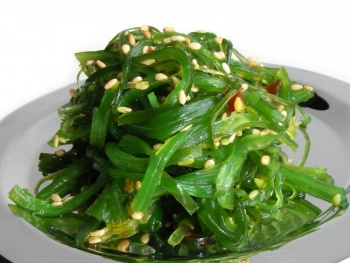Wakame
From Wikiwel
See also :
Undaria pinnatifada or wakame seaweed can be one of the world's most invasive and aggressive species -- capable of growing an inch per day, edging out any local marine life and choking up beaches. However, it's not just a pest. Wakame is actually a delicious and healthy food ingredient in Japanese cuisine. Wakame is seaweed that looks and tastes like a slippery spinach.
Special Precautions of Wakame
The benefits of Wakame are
- Low-Cal Flavoring : Chefs would be first to tell you of wakame's culinary benefits. "The Sydney Morning Herald" describes it as an edible sea vegetable with a delicate, briny flavor. The Japanese have traditionally cultivated wakame by growing it on ropes tied to offshore rafts. It's the seaweed's "leaves" or blades that are harvested. These can be eaten raw or cooked and can be added to soups and salads, for example, to give them that extra "umami" or savory taste. Yet it's only about 4 calories per 10 g of raw seaweed.
- Nutrition : That tiny calorie content in wakame is due to its low levels of fat and carbohydrates. It's also rich in vitamins and minerals. The USDA National Nutrient Database gives a complete nutritional profile of wakame; the list of nutritional benefits includes vitamin A, vitamin C, vitamin E, vitamin K, niacin, pantothenic acid, phosphorus, riboflavin, folate, calcium, iron, magnesium, manganese and copper. Don't go overboard with the wakame, though, as it also contains a high amount of sodium.
- Weight Control : Minerals and vitamins aren't the only thing scientists have found in this brown seaweed. Physorg.com reports chemists in Japan have discovered that wakame contains a compound, fucoxanthin, that seems to reduce the accumulation of fat in animal tests. Fucoxanthin gives wakame its brownish appearance and aids in photosynthesis. This compound appears to stimulate fat oxidation and to stimulate the liver to produce more DHA, a type of omega-3 fatty acid that helps reduce the bad cholesterol associated with heart disease and obesity.
- Anti-Cancer Properties : Wakame also seems to prevent cancer. A 2003 article in "Breast Cancer Research" reported that the sea vegetable is also rich in iodine, which in a previous Japanese study on breast cancer seemed to suppress, even kill, mammary tumors. It's speculated that the iodine in wakame and other seaweeds that are so prevalent in Japanese cuisine are responsible for the relatively low breast cancer rate in both human males and females in Japan. This hypothesis is based on the observed increase in breast cancer rates among Japanese women who turned to a Western-style diet with less seaweed intake.
- Iodine : One hundred grams of it contains approximately 790 micrograms of this essential trace mineral, which regulates the thyroid (which, in turn, regulates the metabolism). Moreover, a 2003 study in the Breast Cancer Research journal confirmed that iodine can inhibit, and even eliminate, mammary tumors. This fact might help to explain why breast cancer is rare in men and women in Japan, where seaweed is regularly incorporated into meals.
- EPA : Wakame is one of the richest plant-based sources of eicosapentaenoic acid in the world. Between one and two tablespoons of wakame provides us with between 15 and 30 milligrams of this important omega-3 fatty acid, which is normally found in fish and can guard us from depression, anxiety, age-related memory issues and even rheumatoid arthritis.
